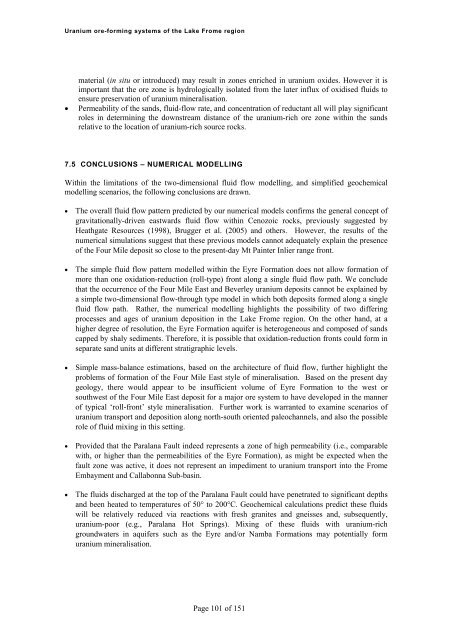Uranium ore-forming systems of the - Geoscience Australia
Uranium ore-forming systems of the - Geoscience Australia
Uranium ore-forming systems of the - Geoscience Australia
Create successful ePaper yourself
Turn your PDF publications into a flip-book with our unique Google optimized e-Paper software.
<strong>Uranium</strong> <strong>ore</strong>-<strong>forming</strong> <strong>systems</strong> <strong>of</strong> <strong>the</strong> Lake Frome regionmaterial (in situ or introduced) may result in zones enriched in uranium oxides. However it isimportant that <strong>the</strong> <strong>ore</strong> zone is hydrologically isolated from <strong>the</strong> later influx <strong>of</strong> oxidised fluids toensure preservation <strong>of</strong> uranium mineralisation.Permeability <strong>of</strong> <strong>the</strong> sands, fluid-flow rate, and concentration <strong>of</strong> reductant all will play significantroles in determining <strong>the</strong> downstream distance <strong>of</strong> <strong>the</strong> uranium-rich <strong>ore</strong> zone within <strong>the</strong> sandsrelative to <strong>the</strong> location <strong>of</strong> uranium-rich source rocks.7.5 CONCLUSIONS – NUMERICAL MODELLINGWithin <strong>the</strong> limitations <strong>of</strong> <strong>the</strong> two-dimensional fluid flow modelling, and simplified geochemicalmodelling scenarios, <strong>the</strong> following conclusions are drawn.The overall fluid flow pattern predicted by our numerical models confirms <strong>the</strong> general concept <strong>of</strong>gravitationally-driven eastwards fluid flow within Cenozoic rocks, previously suggested byHeathgate Resources (1998), Brugger et al. (2005) and o<strong>the</strong>rs. However, <strong>the</strong> results <strong>of</strong> <strong>the</strong>numerical simulations suggest that <strong>the</strong>se previous models cannot adequately explain <strong>the</strong> presence<strong>of</strong> <strong>the</strong> Four Mile deposit so close to <strong>the</strong> present-day Mt Painter Inlier range front.The simple fluid flow pattern modelled within <strong>the</strong> Eyre Formation does not allow formation <strong>of</strong>m<strong>ore</strong> than one oxidation-reduction (roll-type) front along a single fluid flow path. We concludethat <strong>the</strong> occurrence <strong>of</strong> <strong>the</strong> Four Mile East and Beverley uranium deposits cannot be explained bya simple two-dimensional flow-through type model in which both deposits formed along a singlefluid flow path. Ra<strong>the</strong>r, <strong>the</strong> numerical modelling highlights <strong>the</strong> possibility <strong>of</strong> two differingprocesses and ages <strong>of</strong> uranium deposition in <strong>the</strong> Lake Frome region. On <strong>the</strong> o<strong>the</strong>r hand, at ahigher degree <strong>of</strong> resolution, <strong>the</strong> Eyre Formation aquifer is heterogeneous and composed <strong>of</strong> sandscapped by shaly sediments. Theref<strong>ore</strong>, it is possible that oxidation-reduction fronts could form inseparate sand units at different stratigraphic levels.Simple mass-balance estimations, based on <strong>the</strong> architecture <strong>of</strong> fluid flow, fur<strong>the</strong>r highlight <strong>the</strong>problems <strong>of</strong> formation <strong>of</strong> <strong>the</strong> Four Mile East style <strong>of</strong> mineralisation. Based on <strong>the</strong> present daygeology, <strong>the</strong>re would appear to be insufficient volume <strong>of</strong> Eyre Formation to <strong>the</strong> west orsouthwest <strong>of</strong> <strong>the</strong> Four Mile East deposit for a major <strong>ore</strong> system to have developed in <strong>the</strong> manner<strong>of</strong> typical ‘roll-front’ style mineralisation. Fur<strong>the</strong>r work is warranted to examine scenarios <strong>of</strong>uranium transport and deposition along north-south oriented paleochannels, and also <strong>the</strong> possiblerole <strong>of</strong> fluid mixing in this setting.Provided that <strong>the</strong> Paralana Fault indeed represents a zone <strong>of</strong> high permeability (i.e., comparablewith, or higher than <strong>the</strong> permeabilities <strong>of</strong> <strong>the</strong> Eyre Formation), as might be expected when <strong>the</strong>fault zone was active, it does not represent an impediment to uranium transport into <strong>the</strong> FromeEmbayment and Callabonna Sub-basin.The fluids discharged at <strong>the</strong> top <strong>of</strong> <strong>the</strong> Paralana Fault could have penetrated to significant depthsand been heated to temperatures <strong>of</strong> 50° to 200°C. Geochemical calculations predict <strong>the</strong>se fluidswill be relatively reduced via reactions with fresh granites and gneisses and, subsequently,uranium-poor (e.g., Paralana Hot Springs). Mixing <strong>of</strong> <strong>the</strong>se fluids with uranium-richgroundwaters in aquifers such as <strong>the</strong> Eyre and/or Namba Formations may potentially formuranium mineralisation.Page 101 <strong>of</strong> 151
















